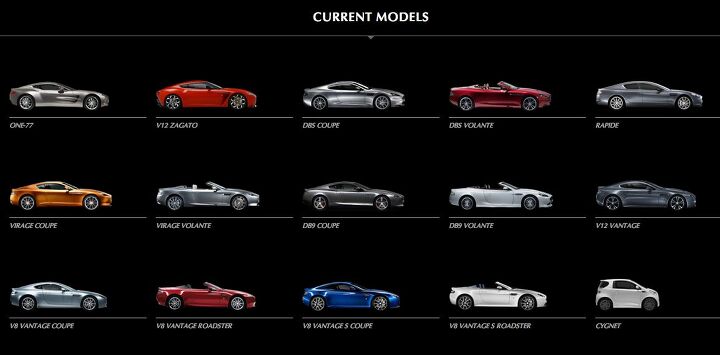Ask The Best And Brightest: Is Aston-Martin A Bit Old Hat?
Ian Callum, designer of the Aston-Martin DB7 (along with the new Jaguars and numerous other gorgeous things) is a really, genuinely nice guy. But even nice guys have their limits, and having seen his groundbreaking Aston design evolve with the morphological dynamism of a sturgeon over the last 17 years, Callum appears to have reached his. Bloomberg reports:
It’s still that same old basic design,” Ian McCallum, who designed the DB9 and is now design director at Tata Motors Ltd. (TTMT)’s Jaguar Land Rover unit, said in a July 27 interview. “Some will argue that if it ain’t broke, don’t fix it. But you do get to a time when you have to move on.”
Sadly, there are a few factual distractions to deal with here before we dig further into Aston’s predicament. First of all, though a Scot, the man’s name is Callum, not McCallum. Also, it’s not clear how much of the DB9 was styled by Callum, and how much was finished by his successor, Heinrik Fisker. Clear? OK, back to Aston…
The models are starting to have a slight whiff of Sunday dinner being used in sandwiches later in the week. It leaves the impression of a company stretching itself as far as it can. In the industry that they operate in, with their competitors, they really need to be cutting edge.
The stuck-in-time, across-the-line styling is part of the problem. A platform that was the talk of the enthusiast committee in 2003 is the other part. A resurgent, Callum-designed Jaguar lineup doesn’t help. Plus, split-the-difference “new” models certainly don’t mask the scent of death well, nor do Toyota rebadges. The prosecution rests.
And what of the defense? Well, all Astons may look the same and be technologically outdated, but they’re still pretty damn good looking. Also,
“All the projects that we are doing have to make a profit,” Chief Executive Officer Ulrich Bez, 66, told journalists at the company’s Gaydon headquarters. “We can’t afford a project that is just a marketing tool.”
The strategy has pushed up the average price of Aston Martin cars 49 percent to 104,000 pounds last year from 70,000 pounds in 2007, the company said at the July 6 briefing.
By recycling technology and using engines from Ford, Aston Martin can keep costs and development times down. That’s secured Aston Martin a profit margin of about 20 percent, nearly double Mercedes’s 10.7 percent return on sales in the second quarter.
Twice the profit margin of Mercedes? That’s nice, but how long will it last when
Daimler AG (DAI), the parent of Mercedes-Benz, plans to spend about 5 billion euros ($7.1 billion) this year on research and development. That’s more than eight times the Gaydon, England-based company’s revenue of 509 million pounds ($830 million) for the 12 months ended March 31.[?]
The sad irony of Aston’s flirtation with over-the-hill, passé status is that it still hasn’t held an IPO, but is waiting for “the right window” (i.e. when the market comes back). By the time that happens, could it be too late for the last independent global British sportscar brand?
More by Edward Niedermeyer
Latest Car Reviews
Read moreLatest Product Reviews
Read moreRecent Comments
- FreedMike Apparently this car, which doesn't comply to U.S. regs, is in Nogales, Mexico. What could possibly go wrong with this transaction?
- El scotto Under NAFTA II or the USMCA basically the US and Canada do all the designing, planning, and high tech work and high skilled work. Mexico does all the medium-skilled work.Your favorite vehicle that has an Assembled in Mexico label may actually cross the border several times. High tech stuff is installed in the US, medium tech stuff gets done in Mexico, then the vehicle goes back across the border for more high tech stuff the back to Mexico for some nuts n bolts stuff.All of the vehicle manufacturers pass parts and vehicles between factories and countries. It's thought out, it's planned, it's coordinated and they all do it.Northern Mexico consists of a few big towns controlled by a few families. Those families already have deals with Texan and American companies that can truck their products back and forth over the border. The Chinese are the last to show up at the party. They're getting the worst land, the worst factories, and the worst employees. All the good stuff and people have been taken care of in the above paragraph.Lastly, the Chinese will have to make their parts in Mexico or the US or Canada. If not, they have to pay tariffs. High tariffs. It's all for one and one for all under the USMCA.Now evil El Scotto is thinking of the fusion of Chinese and Mexican cuisine and some darn good beer.
- FreedMike I care SO deeply!
- ClayT Listing is still up.Price has been updated too.1983 VW Rabbit pickup for sale Updated ad For Sale Message Seller [url=https://www.vwvortex.com/members/633147/] [/url] jellowsubmarine 0.00 star(s) (0.0) 0 reviews [h2]$19,000 USD Check price[/h2][list][*] [url=https://www.ebay.com/sch/i.html?_nkw=1983 VW Rabbit pickup for sale Updated ad] eBay [/url][/*][/list] Ceres, California Apr 4, 2024 (Edited Apr 7, 2024)
- KOKing Unless you're an employee (or even if you are) does anyone care where physically any company is headquartered? Until I saw this story pop up, I'd forgotten that GM used to be in the 'Cadillac Building' until whenever it was they moved into RenCen (and that RenCen wasn't even built for GM). It's not like GM moved to Bermuda or something for a tax shelter (and I dunno maybe they ARE incorporated there legally?)

































Comments
Join the conversation
The DB9 and V8 vantage are sculpture with a soundtrack. I can see why they're doing what they're doing, after all how many 911 variants are there? It is as close to my perfect vehicle as exists (I use the nav on my phone anyways).
Yeah, Callum was heavily involved with the DB7, but it is grossly unfair to Keith Helfet to suggest that it was Callum's design. http://www.aronline.co.uk/blogs/2011/07/23/concepts-and-prototypes-jaguar-xj4142/